This is your quick guide to kombucha pH, including how to track the acidity of your home brew, how to lower the pH, and why acidity matters!

Kombucha and acidity have a close relationship, and you’ll know it if you’ve ever tasted a finished batch of kombucha! Because as the kombucha ferments, the acidity levels of the tea change drastically, and it’s a relationship home brewers should understand in order to make the best (safest) kombucha.
But to start – what is acidity anyways? Acidity is a measurement of hydrogen ions in a substance. When there are more hydrogen ions, the substance is more acidic.
We measure acidity on a pH scale ranging from 0 to 14. A lower pH means something is acidic, while a higher pH indicates that something is alkaline (or basic). So for reference, battery acid would be very acidic with a pH of 0, water is neutral with a pH of 7, and drain cleaner is very alkaline with a pH of 14.
Is kombucha acidic?
So is kombucha acidic or alkaline? Kombucha is considered more acidic, with a typical pH between 2.5 and 3.5.
The longer you let kombucha ferment, the more acidic it will become. This is because the yeast in the SCOBY eat the sugars in your kombucha, transforming them into ethanol. The bacteria feed on this ethanol, turning it into acidity and giving kombucha its distinctively tart taste.
“Do you recommend adding vinegar to lower the pH, if I don’t have any more starter liquid to add?”
Yep, you can add distilled white vinegar to lower the pH a bit…
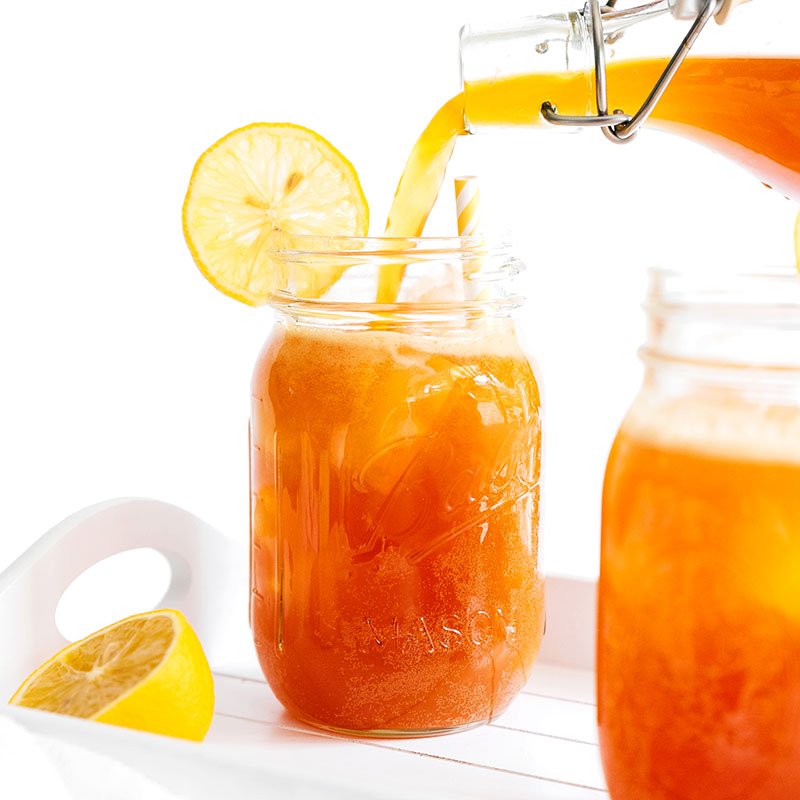
How to track the pH of kombucha
While not totally necessary, you can track the pH of your kombucha if you’re worried that it might be falling outside of a safe pH range.
It’s as simple as buying some pH test strips, dipping them in your brew, and reading the pH results! Be sure to buy pH test strips that go low enough to measure the acidic kombucha (they should measure at least between 1 and 5).
When you start your first fermentation (i.e. right after you’ve combined sweet tea + starter tea), the liquid should be below pH 4.5 (is yours higher than that? read the section below). When the kombucha is finished brewing, it should be between pH 2.5 and 3.5.
But with that said, the pH is not a good indicator of when your kombucha is done fermenting. You just need your taste buds for that! After 7 days in the first fermentation, begin tasting your kombucha every few days until it is the perfect balance of sweet and tart (this is different for everyone). You can check the pH at this point to get an idea of what pH you typically like your finished kombucha to be.
How to lower the pH in kombucha
Acidity is what makes kombucha possible, in that it’s what fights off the bad bacteria! In fact, the FDA states that food under pH 4.6 doesn’t need preservatives because substances under this pH prevent bacterial growth.
Because of this, your starting kombucha needs to be below a pH level of 4.5. When you start a new batch of kombucha, you add starter tea (i.e. plain kombucha) to sweet tea to inoculate the batch. This starter tea is usually enough to bring the pH level below 4.5.
But if your kombucha is still above that level, no worries! Simply add a bit more starter kombucha until you reach a safe pH level under 4.5.
The pH level will continue to drop as the bacteria and yeast in the kombucha produce acidity.
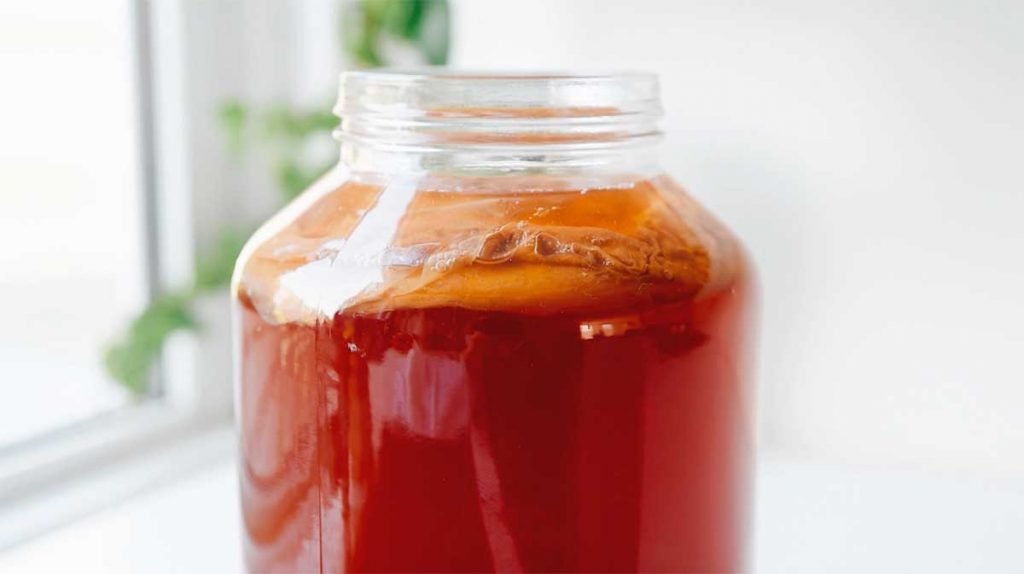
What if my kombucha is too acidic?
Uh oh, you accidentally let your fermentation run for too long, and now your kombucha is acidic and vinegar tasting!
You can try to salvage it by adding a sweetener, like honey or sugar, then moving to the fridge to stop the fermentation.
Or simply bottle the over fermented kombucha and store it in the fridge as a strong starter. It’s likely too sour to drink, but will be a great kickstarter for future batches of kombucha.
Kombucha and acid reflux
With all this talk of acidic kombucha, you may be wondering if there’s any connection between kombucha and acid reflux.
Kombucha isn’t a great option for those suffering from acid reflux…but not entirely because of the acidity. The carbonation in kombucha expands the stomach, which can push acidic stomach acid back up, giving a burning sensation. On top of that, the caffeine and acidity of kombucha can play a role in aggravating acid reflux.
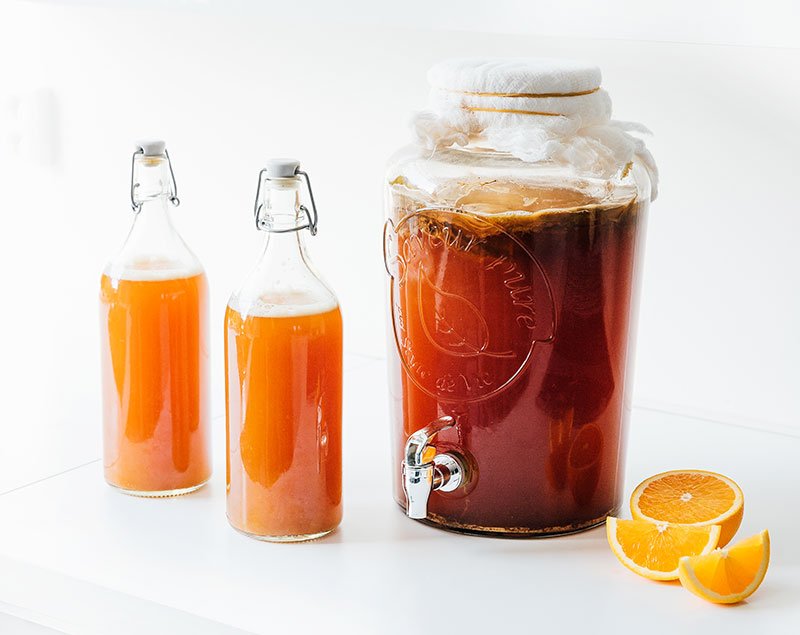
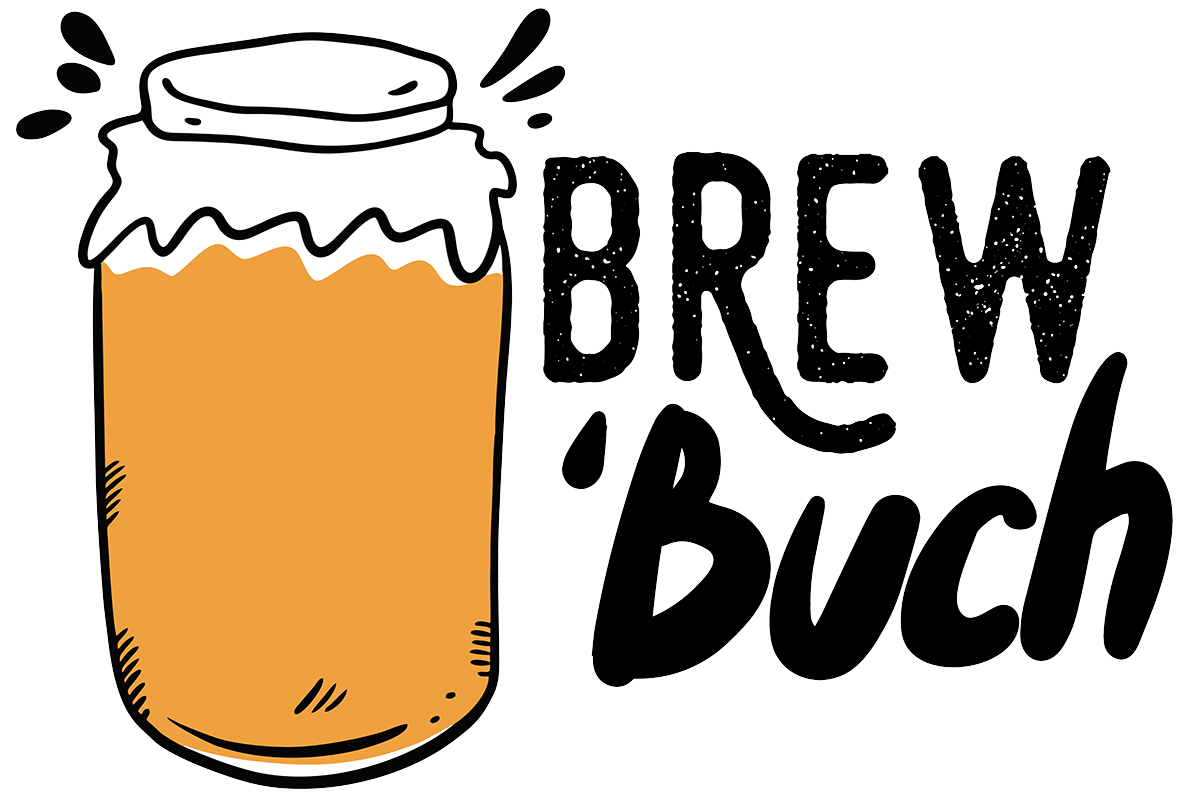
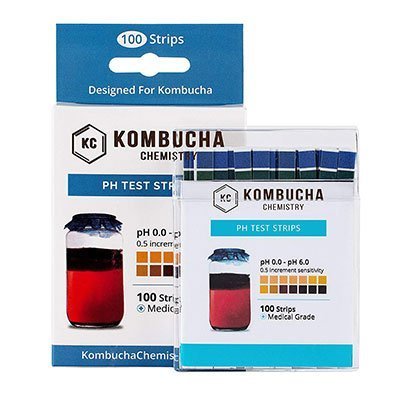
I made two containers of kabucha first jar the scoby is at the bottom and quite dark second jar has a lot of white mould on the top. Should I throw it away and start again
If there is mold then yes, definitely toss that batch! 😀
Hi. My kombucha is on day 5 of the second ferment and the PH level is 4.5. How do I lower that to the recommended 2.5-3.5 level? Thank you!
Just let is keep fermenting for longer (and keep it warmish) 🙂
Hello , how can I tell if my Scoby has mold ? You mention to email you a original but I can’t seem to find a link where to do so
Thanks,
Glenda
Post a photo in our Facebook group and you’ll get a lot of feedback! 😀
Thanks for the article! My Jun Kombucha has been fermenting for just 2 days and has a pH of about 3.0. It tastes sweet and tangy. I would drink it now, but instructions say to give it more than 2 days. Should I give it more time, or do I risk the pH getting too low?
If you like it how it is than it’s ready! pH can be an additional tool to use to help gauge, but #1 is always taste 😀
This past June I had a Whipple surgery. They removed quite alot of my digestive system and have had much trouble since with acid reflux, digesting food, and inflammation in the liver and pancreas.
Last month I heard about kombucha and gave it a try. It has changed my life! After months of pain and agony
I was able to cut my pain meds in half in days. It has been a few weeks now and I am completely off all pain medications. Acid reflux is at a min, I have more energy and can eat more food! My liver and what is left of my pancreas are not working as hard either which is enabling the inflammation to heal.
I am excited to try my batch which should be ready soon. I highly recommend anyone to try drinking it for a couple weeks . It has given me quality of life back!
Thank you to everyone for sharing your knowledge! I enjoy watching my scoby grow , and look forward to experimenting with different flavours.
Hi Coleen, great to hear your success story. How long do you usually ferment your kombucha?
To the comment about Kombucha and acid reflux, a tangential comment: my doctor recommended apple cider vinegar as a treatment for bloating and indigestion (precursor/co-symptom of acid reflux). I’ve suffered from acid reflux for years. I got off proton pump inhibitors by drinking red wine every night (not a big fan). Kombucha has allowed me to reduce my red wine consumption to one glass every week or two. YMMV, etc, etc.
After my second fermentation my Ph is 3.78. Is that safe to drink?
It should be safe at that pH! As always, use your judgement when it comes to taste and smell as well.
I make for the first time kombucha, but at the first day is my pH 2.2
Is this normal?
This pH is a little low, but I would use my taste as a judgment first and foremost! The pH reading could be incorrect perhaps.
My Kombucha is at 3 ph after 1 week of starting it
Hi! The ph of my kombucha is 3.8 after 8 days. Is it safe to do the second fermentation with this level? Thanks in advance!
It should be safe, but I would base more no the taste than the pH. If it tastes how you want it to, then move onto the second ferm 😀
Hi my PH is always 2.0. Is this kombucha
This would be a little low for safe drinking. Try stopping the fermentation a bit sooner!
Hi, so I’ve not long demolished my first batch of Kombucha, I only made 750ml as per the instructions from the starter SCOBY I got from amazon. But this time I’m brewing 1.2l with the old and new scoby from the first batch. Quick question.
On doing this batch I checked the PH of the sweet tea (3/4 black , 1/4 green) which was 5, before adding the starter tea from the first batch, 120ml of it, and it brought the PH down to 3.3? Is this normal or is it too low? I moved onto 2nd ferment at a PH of 3 last time, and this one after only 3 days was already at 3.2. Does it make much difference if a ferment takes 5 days rather than 7+?
This is totally normal! As long as it is within range, pH doesn’t matter much for when you stop the fermentation. Focus more on the flavor of your kombucha as an indicator of when it’s done 😀
Hi,
Quick question: my PH seems to have risen during F2 from 2.3 (… end of F1) to now 3.5 after 7 days …. this seems counterintuitive – is this a known problem?
Hmm I haven’t heard of this before! Have you tasted it to see what is happening to the flavor? All I can think of would be faulty test strips.
great article, can i do my fermentations on a plastic beer fermenter and use a airlock pump to let the pressure escape?
once again, thanks for all the tips and tricks.
Hi Alex! If the plastic is fermentation safe then it should be fine. Don’t use the airlock though. Use a cloth or something breathable so air can come in and out.
I have the same problem my ph is 4.5 after 10 days.
If I add the distilled vinegar, do i move the scoby and pour it in the tea? and how much do I add?
Hi Vicki! I don’t have a ton of experience with adding vinegar so I couldn’t tell you exactly how much. You might drop the question in our Facebook Group for a quick answer!
Do you recommend adding vinegar to lower the pH, if I don’t have any more starter liquid to add?
My pH is sitting at about 5 after about 10 days of first fermentation.
Thanks!
Hi Stephanie! Yep, you can add distilled white vinegar to lower the pH a bit (be sure not to add any raw vinegars).
Is it possible to test the alcohol level of a batch?
I wrote a bit on alcohol in kombucha here. You can use a hydrometer, though the readings aren’t very accurate when testing kombucha due to all the sugars and compounds in the buch. Unfortunately with kombucha there aren’t great options for testing alcohol levels (that I have found anyways).
You need a refractometer and an acid titration kit. Then you can measure the before and after on the sugars in the batch, and subtract the total acid. The happy herbalist has a guide.
Is there a way for your kids to get in trouble with say a Minor in possession for having your homebrew kombucha?
I mean, there is alcohol in kombucha but to get an underage for it might be a stretch! Haha
Is there a way to test the sugar level?
many thanks!
It can be imprecise but it’s possible! Some tips on that here.